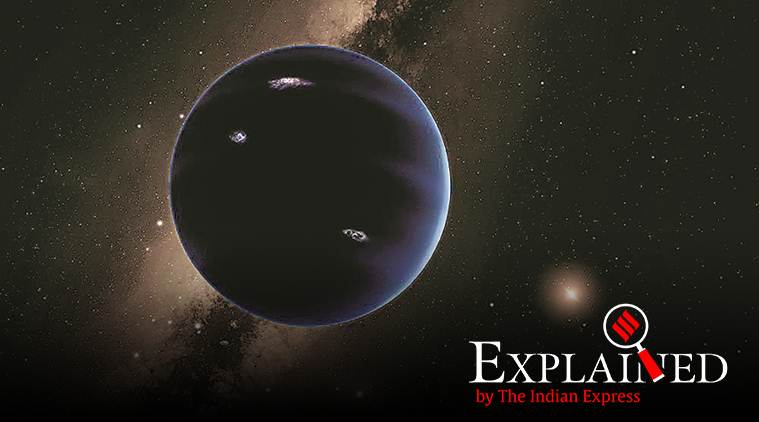Could Planet Nine be a black hole? A new theory, and the case around it
Over the years, scientists have sought to explain several puzzling aspects of the Solar System by attributing these to the influence of Planet Nine.
 Artist’s rendering of the view from Planet Nine towards the sun. (Source: Caltech)
Artist’s rendering of the view from Planet Nine towards the sun. (Source: Caltech)
Hidden in the outer Solar System lurks a presence, believed to be a gigantic planet orbiting the same Sun and casting a visible influence on the behaviour of a number of other objects. Although it has not yet been spotted, this behaviour would be difficult to explain if such a presence did not exist. It is popularly referred to as Planet Nine, the presumed ninth planet of the Solar System, and occasionally as Planet X.
What if this mysterious presence were a tiny black hole instead? That is an idea proposed by two physicists, who have shown that the behaviour of certain Trans-Neptunian Objects — those beyond the orbit of Neptune — can also be explained by the presence of a primordial black hole.
A primordial black hole is one that is believed to have formed immediately after the creation of the universe. Like Planet Nine, primordial black holes too have been predicted to exist — including by the late Stephen Hawking — but none has been spotted as yet.
The physicists are not ruling out a planet either. “All we are suggesting, is that if the anomalies persist, while no planet is found in the visible spectrum, we should start looking for alternative scenarios,” Jakub Scholtz of Durham University says in an online post. The other physicist is James Unwin of the University of Illinois at Chicago.
What do we know of Planet Nine so far?
Over the years, scientists have sought to explain several puzzling aspects of the Solar System by attributing these to the influence of Planet Nine. In a 2016 paper, California University of Technology researchers Konstantin Batygin and Michael Brown made out a case for Planet Nine’s existence by arguing that it could be responsible for the peculiar alignment of icy objects on the outskirts of the Solar System.
Again, the Sun’s equatorial plane is aligned six degrees off from the orbital plane of the planets. What if it is not the Sun that is out of alignment but the eight planets? This proposal came from another Caltech team, again in 2016; they argued with calculations that Planet Nine’s mass has caused their orbital plane to wobble.
Since then, more and more peculiarities have been attributed to Planet Nine, including the extreme tilt of an object called 2015 BP519, and the orbit of a dwarf planet called the “Goblin”. Last year, The Indian Express had emailed questions about Planet Nine to a number of researchers. Batygin of Caltech had felt “the false-alarm probability with the current set of objects is about 0.1%”. Juliette Becker of the University of Michigan, who had studied BP519 and made a case for Planet Nine, had said “the only way to prove the existence of Planet Nine is to directly detect it”. And Scott Sheppard of the Carnegie Institution for Science, part of the team that discovered the Goblin, was then “about 85% sure the planet exists”.
What, then, is the basis of the new suggestion about a black hole?
Scholtz and Unwin, who have published their findings on a preprint server, base their theory on two known gravitational anomalies, both attributable to the same mass. One is the unusual orbits of asteroids beyond the orbit of Neptune, which have fed the prediction of Planet Nine, estimated to be somewhere between 5 and 20 times the mass of the Earth.
The other anomaly was observed thousands of light years away, by a project called the Optical Gravitational Lensing Experiment (OGLE). In six observations, an object bent the light of a star. This is called microlensing, Scholtz and Unwin told The Indian Express in a joint email. These six events correspond to objects whose masses are in the range 0.5 to 20 times the mass of Earth. Scholtz and Unwin took these to be primordial black holes, and explored if one of these black holes could have been captured by the Solar System and was also causing the unusual orbits of the asteroids.
“We have calculated that the likelihood of capturing a free planet (which is one of the possible explanations for Planet 9 origin) is very similar to the likelihood of capturing one such black hole. This is why we believe that this is a somewhat reasonable scenario,” they wrote in their email.
Can the black hole be found?
The catch is that it is much harder to look for a black hole than to look for a planet, especially when the black hole is predicted to be of small dimensions. “However, it is reasonable to expect a dark matter halo surrounds this black hole. If dark matter can annihilate into particles we know, the halo surrounding the black hole would radiate high energy photons and the halo would be visible in X-rays and gamma rays,” Schotz and Unwin said. They propose to look through a gamma ray telescope dataset and try to find evidence of these annihilations.
- 01
- 02
- 03
- 04
- 05





































